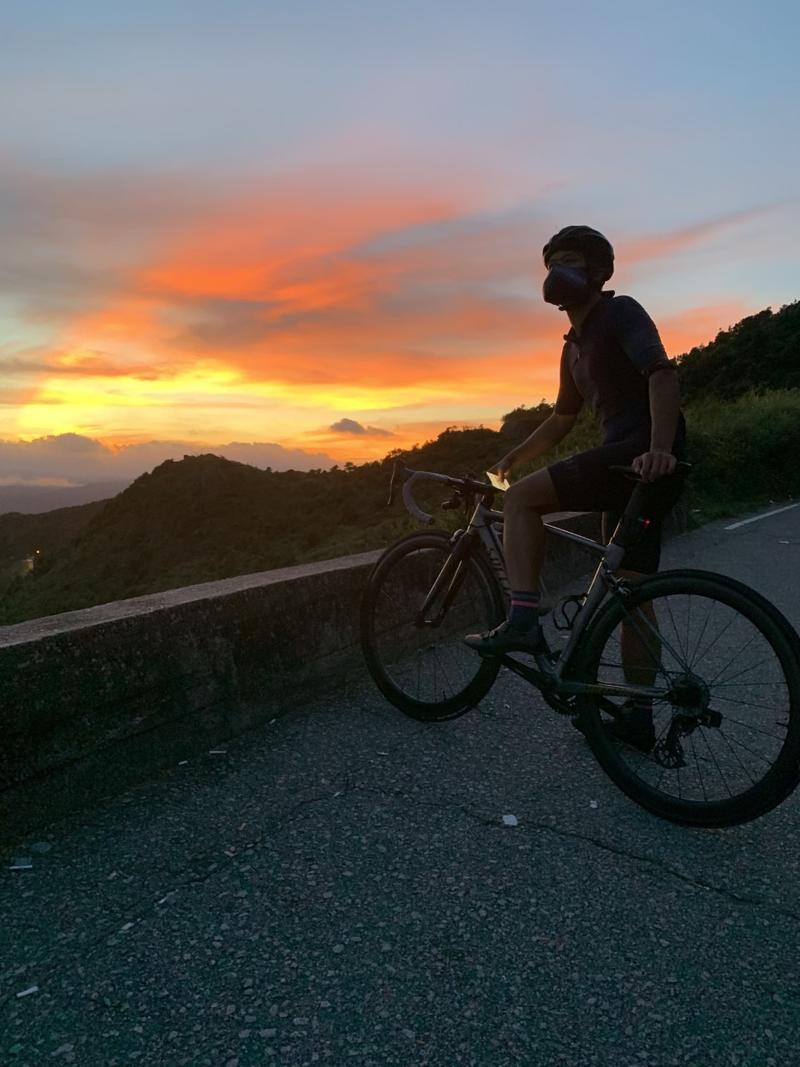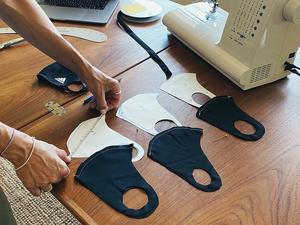Joyce Yip explores whether reusable masks for sportspeople is a good idea or even a healthy one.
 Nplus1.cc co-founder Kirk Kowk hopes the extra effort required during masked rides will help improve his performance. (PHOTO PROVIDED TO CHINA DAILY)
Nplus1.cc co-founder Kirk Kowk hopes the extra effort required during masked rides will help improve his performance. (PHOTO PROVIDED TO CHINA DAILY)
Although he had stepped out at 7:30 am to beat the stifling summer heat, 28-year-old Spartan Race ambassador Douglas Chan had to cut short an outdoor run due to fatigue and dehydration. This was the first time he had given up before completing a circuit. It was Aug 8, 10 days after wearing masks outdoors was made mandatory and Chan’s first time running with a blue surgical mask plastered on his face in 31 C heat.
“Six kilometers into the run my pace was already dropping — it was barely a running pace — and I was already feeling tired. My normal running heart rate is 140 to 150 bpm (beats per minute) but on my way up Bowen Road in Central that day my heart was pumping at 170 bpm. This is a signal I am under a high load and am probably dehydrating,” Chan says.
As an active trail runner and five-time participant in the world-renowned Spartan obstacle race comprising barbed wire crawls, wall climbs, tire flips and more, he says that the planned half marathon from Kennedy Town to the Peak and down to Wan Chai “wouldn’t be pleasurable but doable” if he could breathe freely.
In response to the spike in COVID-19 cases in Hong Kong in July, the local government limited group gatherings to two people and made mask-wearing mandatory in outdoor public places. The rule came into effect on July 29 and included people exercising outdoors. With sports facilities and swimming pools forced to close their doors, gym junkies and workout enthusiasts were left with no choice but to move their routine out into the unforgiving heat, with a mask smeared across their sweaty faces. However, the local government has since decided to let people unmask themselves while exercising outdoors, with effect from today.
 HKOutsider founder Roland Sharman is not convinced about the efficacy of the reusable masks for sportspeople available in the market. (PHOTO PROVIDED TO CHINA DAILY)
HKOutsider founder Roland Sharman is not convinced about the efficacy of the reusable masks for sportspeople available in the market. (PHOTO PROVIDED TO CHINA DAILY)
Sporty options
To make the experience more bearable, fitness enthusiasts are opting for reusable face covers that boast functions like comfort, breathability, anti-bacteria, disinfection, UV protection, quick absorption and more. Though external scientific research has yet to prove that these reusable options offer the same protection as disposable surgical masks, countless homegrown and mega sports labels like Adidas and Under Armour have jumped on the bandwagon. Prices range from under HK$50 (US$6.5) to nearly HK$600 for one.
Less expensive choices include a mask bracket, which is a plastic or silicone frame that cups the mouth and nose to allow more breathing space between the face and the polypropylene; masks made for fending off pollen and other allergens as well as buffs, or tube-shaped scarves that roll up to cover the mouth and nose. The government doesn’t specify the type of mask to be worn so pretty much anything goes, although experts say the last two options are totally ineffective in preventing the spread of COVID-19.
Roland Sharman, founder and lead guide of HKOutsider’s stream trekking, coasteering, canyoning, rock climbing and hikes off the beaten track, is convinced the reusable alternatives are just a marketing ploy.
 Since the pandemic began, sportswear manufacturers have been working at producing the ideal reusable mask for athletes. (PHOTO PROVIDED TO CHINA DAILY)
Since the pandemic began, sportswear manufacturers have been working at producing the ideal reusable mask for athletes. (PHOTO PROVIDED TO CHINA DAILY)
“As in most things, we have different ways to make money out of it. I don’t think any of these masks are truly designed to offer an alternative that’s functional for sports. They’re just a branding opportunity and a load of rubbish…They won’t stop you from getting the disease — it’s just to comply with the regulation and be seen doing the right, socially conscious thing in public,” Sharman says, adding that his choice of protection is a bandana lifted over his nose and mouth.
HKOutsider has stopped all water-borne activities to lower risks of infection, and even its hiking excursions have become more sporadic and limited to a one-on-one rather than the usual group setting.
“The sort of hiking we do is very steep and energy-demanding so you can’t breathe with a mask, especially with the humidity in Hong Kong. It’s not just a question of whether you’re comfortable or not, but it’s very distracting from a mental standpoint when I’m thinking about where to place my hand or big toe while scrambling up a rock face.”
Working out with a mask on amounts to disregarding World Health Organization’s advice, which warns that a sweat-drenched mask will make breathing difficult and accelerate the growth of microorganisms. Studies suggest that working out with a surgical mask on can result in symptoms like light-headedness, dizziness, numbness or tingling, rapid heart rates and limited oxygen intake, which could lead to shorter endurance, more effort, irritability, lack of focus as well as shallow, rapid breaths. A wet mask is less efficient in filtering both incoming and outgoing bacteria, rendering them practically pointless during sweaty workouts.
 Spartan Race ambassador Douglas Chan is concerned about the adverse effects of exercising with masks on. (PHOTO PROVIDED TO CHINA DAILY)
Spartan Race ambassador Douglas Chan is concerned about the adverse effects of exercising with masks on. (PHOTO PROVIDED TO CHINA DAILY)
Improved performance?
Not all is doom and gloom though. While some studies are concerned about the tripled carbon dioxide that’s recycled back into our lungs during masked workouts, other researchers suggest such restriction of oxygen affords an experience similar to high-altitude training and could help gradually improve overall performance as a result.
Kirk Kwok, a 31-year-old avid cycler and co-founder of cycle club Nplus1.cc, says he’s been more aware of his breathing since he began riding with a mask on.
“Any resistance training will help your body adapt. For me, riding with less oxygen trained me to control my heart rate, and I am consciously controlling my output and thinking about how fast and how long I can go. Speed for me wasn’t reduced that much, but for sure riding with a mask takes 10 to 20 percent more effort,” he says.
As of now he is using a reusable pure carbon activated mask by US-based manufacturer Training Mask; which costs $70 plus shipping.
“A lot of people are selecting allergen-fending masks, but I found it pointless to wear a mask for the sake of just wearing one. It defeats the point if they’re not blocking out the virus or if they’re not helping me breathe easily,” he says. “I want to prove a point to people who think that working out under this pandemic is impossible and uncomfortable. I am interested to see whether or how it improves my fitness.”
Though Chan doesn’t quite share Kwok’s optimism, he has accepted the inevitability of masked workouts in the near future and purchased both a mask bracket and a fabric antibacterial face cover from South Korea since his failed attempt at running a half-marathon early in August. Albeit the latter came with a promise of comfort and breathability, the problem of masks accumulating sweat seems to persist.
“They’re both great when the mask is dry, but all you’ll be breathing is sweat vapors once they get soaked. It’s suffocating,” he says. The alternative is to occasionally pull the mask down to catch a precious breath of fresh air during his morning run, at the risk of being slapped a fine of HK$5,000.
“I just have to get used to it because COVID-19 isn’t going away any time soon. I just want to find something that I can breathe through,” Chan says.



